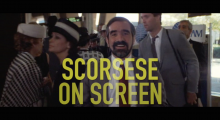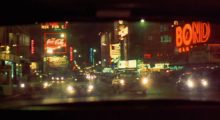Martin Scorsese
-
NYFF 2019: Bacurau, Varda by Agnès and The Irishman

A number of cinematic styles, narrative modes, and political agendas collide in Bacurau, one of two South American films on NYFF’s Main Slate this year. Urgent, yet vague enough to feel timeless, the film depicts a form of unhinged white supremacy in the outback of northern Brazil. We’re told up top, quite ominously, that Bacurau takes place “a few years from now,” as if to suggest that the wholly irrational racism herein is just around the corner. An angry movie, at once frightening and funny, it’s bound to rattle viewers aesthetically, politically, or both. Bacurau, a fictional town, is already […]
by Soheil Rezayazdi on Oct 9, 2019 -
NYFF 2019: The Irishman

The opening shot of The Irishman* is a signature Steadicam glide through a nursing home soundtracked by doo-wop (The Five Satins’ 1956 “In The Heat of the Night”), slowly making its reverential way to an close-up of Robert De Niro—a suitably majestic re-introduction of both the actor as persona and his character, hitman Frank Sheeran. Sheeran lived until 2003, and (minus one brief WWII combat service flashback) the film picks him up sometime in the early ’50s. If the opening shot is as close to the present day as possible (2003, I hate to remind you, was already 16 years […]
by Vadim Rizov on Sep 30, 2019 -
Rolling Thunder Revue: A Bob Dylan Story by Martin Scorsese: Tangled Up in Tanner

On a scale of one to ten, I’m probably about a 6.5 when it comes to Bob Dylan. Define one as “Dylan is the single most visible/still living manifestation of hyper-steroidal Boomer nostalgia and must be destroyed,” ten as the level of obsessiveness practiced by the singer-songwriter’s personal scourge A.J. Weberman, who literally coined the term “Dylanology” and famously dug through Robert Zimmerman’s trash for clues. Dylan wasn’t having it; in Weberman’s indelible telling: I’d agreed not to hassle Dylan anymore, but I was a publicity-hungry motherfucker… I went to MacDougal Street, and Dylan’s wife comes out and starts screaming […]
by Vadim Rizov on Jun 10, 2019 -
Outta Respect

“We tried to do everything we could.” “What do you mean?” “You know what I mean. He’s gone. And we couldn’t do nothing about it.” So kicks off an iconic sequence in Martin Scorsese’s Goodfellas, the emotional summit of a movie that’s basically one iconic sequence after another: the moment on the pay- phone when Jimmy “The Gent” Conway (Robert De Niro) hears his old friend Tommy DeVito (Joe Pesci) has just been whacked. Jimmy doesn’t just hang up — he bashes the phone into the receiver, finally stomping the booth into the ground between muffled sobs while the film’s narrator, […]
by Steve Macfarlane on Dec 14, 2017 -
Watch: “The Invisible Thelma Schoonmaker,” Martin Scorsese’s Editor

This video essay examines Thelma Schoonmaker’s key contributions to Martin Scorsese’s work by taking a closer look at two scenes from Raging Bull. Bonus: footage of the Scorsese exhibition currently on display at the Eye Filmmuseum in Amsterdam.
by Filmmaker Staff on Jul 12, 2017 -
Martin Scorsese’s World Cinema Project, Ghost World and The Last Word: Jim Hemphill’s Home Video Picks

Martin Scorsese famously considered becoming a priest before taking another path, and he clearly never lost the evangelical impulse. In the 38 years since Scorsese used his influence and finances to restore and rerelease Michael Powell’s Peeping Tom, he has done more to spread the gospel of cinema than any other director in film history, devoting countless hours to film preservation and education while simultaneously amassing a body of work that in its breadth, depth, and quality rivals that of any of the masters his scholarly efforts aspire to honor. In 2007 Scorsese embarked on one of his most important […]
by Jim Hemphill on Jun 2, 2017 -
Watch: “Scorsese Onscreen”

This video by Leigh Singer assembles Martin Scorsese’s many on-screen appearances in his own films.
by Filmmaker Staff on Mar 15, 2017 -
Watch: Martin Scorsese’s Romance with New York City

This new video essay by Leigh Singer from the BFI posits, not so controversially, that director Martin Scorsese and the location of New York City are one of cinema’s great screen couples: This video essay focuses exclusively on Scorsese’s features and argues that, in his hands, the physical place transforms into psychological space: an X-ray not just of a city’s psyche, but of a nation’s soul. It makes for often brutal viewing, rarely indulging the aspirational side of the American Dream (does the Statue of Liberty feature even once in a Scorsese film?); but few can deny its authenticity. And […]
by Scott Macaulay on Feb 3, 2017 -
Watch: “Kazan, Scorsese and The Departed“

With Silence out soon, it’s Martin Scorsese season. This video essay by Cole Smith looks at Elia Kazan’s approach to staging interior and urban spaces in films such as A Streetcar Named Desire and On the Waterfront, then moves on to consider his influence on Scorsese’s The Departed. New Yorkers: the film shows on 35mm this Saturday at the Museum of the Moving Image.
by Filmmaker Staff on Dec 12, 2016 -
Watch: A Scorsese Fast Dolly Zoom-In Supercut

From faces to guns to cocaine to pasta sauce, the fast dolly zoom-in is one of Martin Scorsese’s go-to expressive camera moves. Here, Jorge Luengo Ruiz compiles four-minutes of them in what is both great mid-day cinematic eye candy as well as something of a critique. Ruiz writes: Martin Scorsese’s penchant for a specific kind of zoom, one where he runs the camera right up to the face of his subject, falls somewhere in between the subtle and the obnoxious. Seduced as we are by the style and panache of Scorsese’s oeuvre, we let this habit of his pass us […]
by Scott Macaulay on Nov 1, 2016










